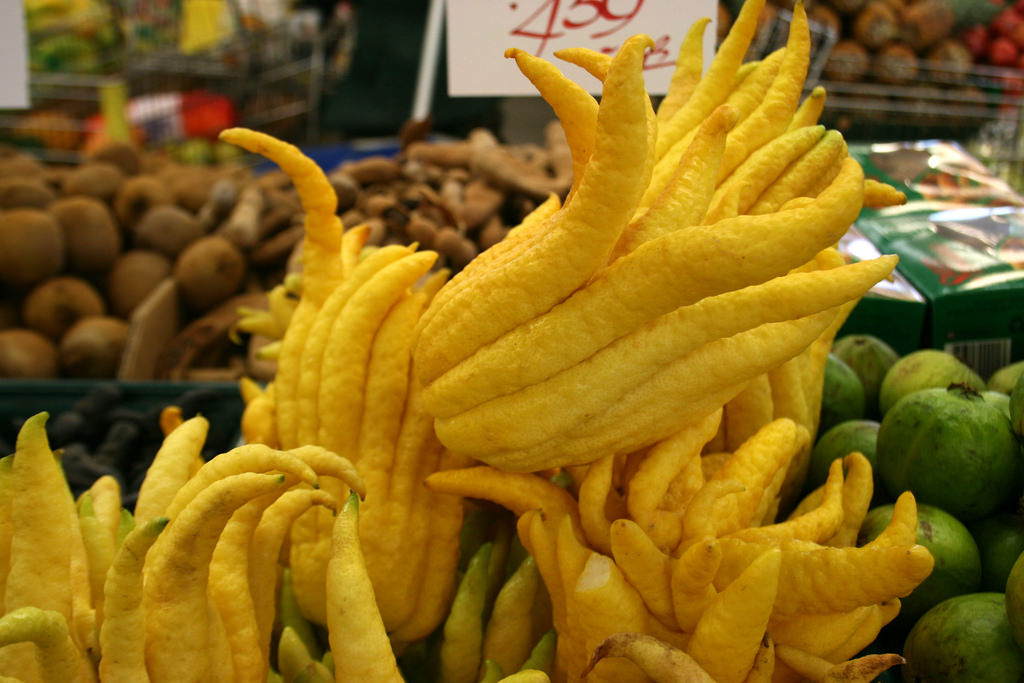
You might also like:
ASIA may be a haven for street food, but its range of native and tropical fruits are just as exhilarating.
Durian
Try in: Malaysia, Singapore, Indonesia, Thailand
It’s not a list of unusual fruits without durian. Fondly known as the “king of fruits” in Southeast Asia, durian smells as oddly as it looks. Its pungent scent has even caused the fruit to be banned in many public places, including on the Singapore Rapid Mass Transit. Travel host and writer Anthony Bourdain has famously laid out the consequences of eating the fruit: “Your breath will smell as if you’d been French-kissing your dead grandmother.” Despite the controversy, durian is a fruit that has luxuriously creamy flesh, sometimes folded into cake batters, ice cream and cream puffs. When eaten at its prime, the flesh is both rich and sweet with inexplicably savory undertones.
Buddha’s hand. Pic: dotpolka/flickr
Buddha’s hand
Try in: China, Japan
Despite the fact that the Buddha’s hand looks about ready to reach out and wrap its fingers around your throat, the fruit’s soothing lemon-blossom, lavender scent more than makes up for it. Because of its natural perfume, the fruit is used to scent rooms and clothing in China and Japan. One wouldn’t generally eat the fruit raw because of it containing no pulp or juice, but it can be consumed sliced and dried. Much of its use lies in the rind, whose acidity can be used to flavour desserts, sugars, cocktails and marmalade. It has a bright zing, so a little will go a long way. Bear in mind that the fruit is sometimes sold as Fingered Citron.

Akebi. Pic: 克年 三沢/flickr
Akebi
Try in: South Korea, Japan
At first glance, a ripened akebi – or chocolate vine – resembles a brilliantly purple potato. But once it’s sliced open, it contains translucent white flesh in a slimy consistency, much like chia seeds that have been soaked in water. The flesh can be eaten raw, slurped straight from the pod. It’s your choice to spit the seeds out or swallow them, but if you’re going for the latter option, we’d recommend gulping down the pulp together with the seeds so they go down easily. In Japan’s Tohoku region, the fruit was once combined with salt to pickle cucumber, or stuffed and deep-fried. Akebi is only available for two weeks a year in early autumn, and is considered a rare delicacy.

Water apple
Try in: India, Taiwan, Malaysia, Indonesia, Philippines, Thailand
These bell-shaped fruits are immediately noticeable for their pretty pink tinge and glossy skins. Sometimes referred to as rose apples, these fruits are juicy, crunchy, tart and oddly spongey. In India, the fruit is cultivated in the district of Andhra Pradesh and is often used as a tonic for the brain and liver. However, in Kerala, the apple’s natural crunchiness is capitalised and made into pickles to be used as a savory condiment alongside rice. In Malaysia, the fruit is commonly sold at street-side fruit vendors, sliced and liberally doused with assam or sour plum powder. A note: Despite its name, water apples are not a species of apple.

Pulasan. Pic: Jeff and Neda Fields/flickr
Pulasan
Try in: Malaysia, Philippines
Don’t judge the pulasan’s spiky, leathery exterior. Once pried open, the globular pods contain sweet, juicy flesh that’s incredibly refreshing in the hot weather. While the fruit is a cousin to the hairy, more theatrical rambutan, pulasan separates easily from the seed, which is edible and tastes mildly of almond. In the same family of pulasan is longan and lychee, both incredibly sweet and floral-like, and a bonus when used in chilled cocktails at some of Malaysia’s upmarket bars. Longan is also known as mata kucing, and when juiced and chilled, is an instant pick-me-up in the scorching afternoons.
Source: travelwireasia.com



